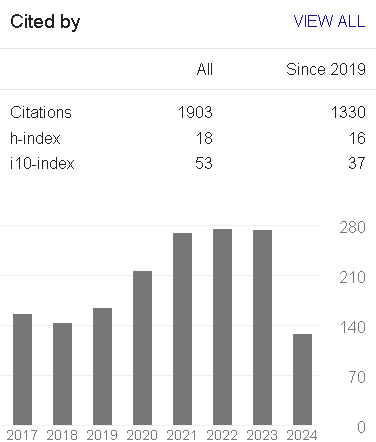Generating 3D dataset of gait and full body movement of children with autism spectrum disorders collected by kinect v2 camera
Keywords:
Autism spectrum disorders, Kinect v2, Gait analysis, body movement analysis, 3D-skeleton-based gait dataset, Dataset augmentationAbstract
Until now, a three-dimensional dataset combines gait and body movement analysis of children with Autism Spectrum Disorders (ASD) in controlled environments has not been published. ASD mean disorders of neurodevelopment that last a lifetime which occurs in early childhood and usually associated with unusual movement and gait disturbances. Threedimensional gait features captured by Kinect v2 can assist clinicians in diagnosing, clinical decision-making, and treatment planning of ASD. In this paper, Kinect v2 uses to build a 3D-skeleton-based gait dataset, which includes joints positions, the corresponding skeleton movement video, joints trajectories video captured by Kinect v2, and color videos captured by Samsung Note 9 rear camera. Besides building dataset, this paper classifies children with ASD from normal children by proposed system comprises four main stages: 1) Augmentation the database by using seven transformations to solve the problem of the small number of ASD cases, 2) Extracting features that we think play an important role in classification, 3) Reducing data dimensions using Principal Component Analysis (PCA) and 4) Using Multilayer Perceptron (MLP) to classify data. Classification accuracy when using eleven features result from PCA and MLP is 95% with 0.7 seconds to build the model.
References
American Psychiatric Association, Diagnostic and Statistical Manual of Mental Disorders (5th Edition), 5th ed. Zagreb: Naklada Slap, Jastrebarsko, Croatia, 2013
L. Smith et al., What is stimming, MedicalNewsToday, Feb. 2018. [Online]. Available: https://www.medicalnewstoday.com/articles/319714. Last Accessed: 17 May 2020.
M. Rahman, “Beginning Microsoft Kinect for Windows SDK 2.0: Motion and Depth Sensing for Natural User Interfaces”, 1st ed. Montreal, Quebec, Canada: Apress, 2017.
A. Jubouri and I. Ali, “A survey on movement analysis (hand, eye, body) and facial expressions-based diagnosis Autism spectrum disorders using microsoftkinect v2,”COMPUSOFT, An International Journal of advanced Computer Technology, vol. 9, Issue.1, pp. 3566-3577, Jan 2020. [Online]. Available: DOI: http://dx.doi.org/10.6084/ijact.v9i1.1045
D. Rubin, "Statistical Matching Using File Concatenation with adjusted Weights and Multiple Imputations". Taylor & Francis: Journal of Business & Economic Statistics, 1986.doi:10.2307/1391390.
R. Little, "Missing-Data adjustments in Large Surveys, “Journal of Business & Economic Statistics, vol.6, no.3, pp. 287–296, June 1988. [Online]: doi:10.2307/1391878.
J. Foley, “Introduction to Computer Graphics,” California: addison-Wesley, 1994.
Gartia, “Project 3: Camera Calibration and Fundamental Matrix Estimation with RANSAC,” Georgia Tech, GTID: 903136557. Accessed on: 16 Mar. 2020, Available: https://www.cc.gatech.edu/classes/AY2016/cs4476_fall/results/proj3/html/agartia3/index.html
T. Motta et al.,” Kinect Projection Mapping,” SBC Journal on Interactive Systems, vol. 5, no. 3, 2014
F. Berchtold and J. Hausen, “Homogeneous coordinates for algebraic varieties,” Journal of Algebra, vol.266, no.2,pp. 636–670, 2003. [Online]. Available: doi:10.1016/S0021-8693(03)00285-0.
M. Karg et al., “Recognition of Affect Based on Gait Patterns,” IEEE Transactions on Systems, Man, and Cybernetics, Part B (Cybernetics), Vol. 40, Issue.4, Mar. 2010, pp. 1050 – 1061. Aug. 2010. [Online]. Available: DOI: 10.1109/TSMCB.2010.2044040.
Q. Wen et al., “Time Series Data Augmentation for Deep Learning: A Survey,” arXiv preprint arXiv:2002.12478. 2020
Downloads
Published
How to Cite
Issue
Section
License
Copyright (c) 2020 COMPUSOFT: An International Journal of Advanced Computer Technology

This work is licensed under a Creative Commons Attribution 4.0 International License.
©2023. COMPUSOFT: AN INTERNATIONAL OF ADVANCED COMPUTER TECHNOLOGY by COMPUSOFT PUBLICATION is licensed under a Creative Commons Attribution 4.0 International License. Based on a work at COMPUSOFT: AN INTERNATIONAL OF ADVANCED COMPUTER TECHNOLOGY. Permissions beyond the scope of this license may be available at Creative Commons Attribution 4.0 International Public License.


